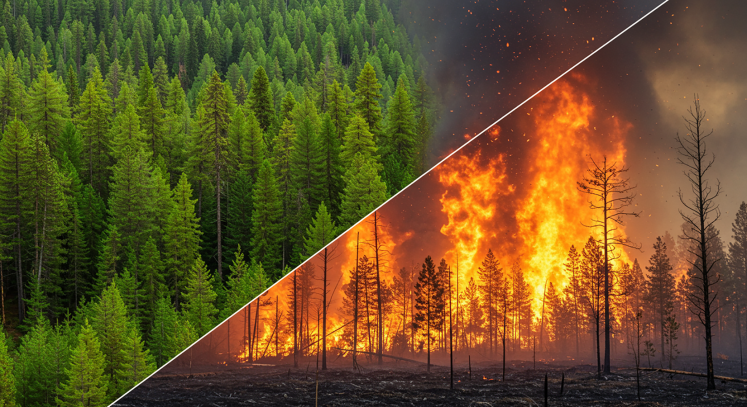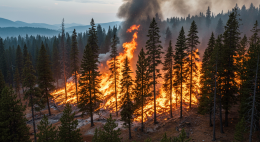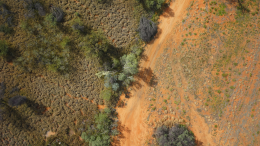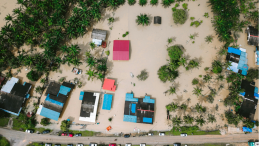Richmond Hill, Canada – 6 May 2025 — Forests once hailed as reliable carbon sinks are rapidly becoming “super‑emitters” as record‑breaking wildfires sweep boreal, Amazonian, and Australian landscapes. Today’s climate policies and voluntary carbon markets seldom account for the sharp rise in fire‑driven emissions. A new publication by the United Nations University Institute for Water, Environment and Health (UNU‑INWEH), Beyond Planting Trees: Taking Advantage of Satellite Observations to Improve Forest Carbon Management and Wildfire Prevention, warns about the unintended consequences of current carbon sequestration projects and policies that overlook the changing conditions of forests. The authors, argue that planting trees can in some cases even increase the risk of wildfires and potentially increase carbon emissions.
“Planting trees is no longer enough—warming, drought‑stressed forests can flip into vast carbon sources when they burn. Forest policy must move from static protection to dynamic risk management,” said Dr. Ju Hyoung Lee, Environmental Remote Sensing and Spatial Hydrology Research Fellow at UNU-INWEH, who led the policy brief.
According to the UNU scientists, carbon‑offset programmes must shift from simply rewarding tree‑planting to accounting for how warming, drought and pests can turn expanding forests into major fire‑driven carbon sources. Policies should evaluate local hydrological and thermal conditions—precipitation, soil health, projected droughts and heatwaves—and include active fuel‑management measures.
“Forests are our powerful allies against climate change—but only if we manage them as living, dynamic systems. By coupling satellite data with proactive management, we can prevent fires from erasing decades of carbon‑reduction progress,” said Professor Kaveh Madani, Director of UNU‑INWEH.
Rising temperatures are reshaping forests and their carbon‑storage potential, yet carbon‑offset markets still rely on static assumptions and overlook wildfire‑driven emissions. The publication explains how forest management and carbon offsetting policy making could be significantly strengthened through integration of earth observation and near real time monitoring of changing forest conditions. According to the authors, satellite data can pinpoint areas where accumulating tree growth creates significant wildfire risk. This information allows policymakers to strategically exclude high-risk areas from carbon offset initiatives and develop more effective, proactive management plans.
The policy brief calls for creation of a dedicated global platform to channel timely satellite observations into voluntary carbon markets and fire-management programs. This integration would help to align financial incentives with the evolving and often drought-prone realities of our warming ecosystems.
Key messages:
- In many parts of the world, forests and peatlands, previously considered to be the largest terrestrial carbon storehouses, are transitioning into super carbon emitters under warming conditions, due to large and frequent wildfires.
- Carbon mitigation actions and policies— including carbon pricing, credit verification, and Voluntary Carbon Market (VCM) projects under the forestry and land-use category, as well as the Paris Agreement— fail to properly account for wildfire-related carbon emissions.
- Natural carbon sequestration in dry soils through forestation policies might be ineffective in warming environments with more frequent wildfires.
- Under certain conditions and mostly in arid and warming environments where the efficiency of photosynthesis is reduced, controlled harvesting and grazing could be actively considered as a strategy for maintaining soil and vegetation moisture and preventing increased carbon emissions.
- A global platform of near-real-time satellite observations of forest conditions is needed to ensure transparency and accountability of VCMs in accordance with the changing conditions of forests under global warming.
The UNU research team is available for interviews:
Dr. Ju Hyoung Lee, Research Fellow, Environmental Remote Sensing and Spatial Hydrology, juhyoung.lee@unu.edu
Dr. Mir Matin, Manager, Geospatial, Climate and Infrastructure Analytics Program, mir.matin@unu.edu
Professor Kaveh Madani, Director, kaveh.madani@unu.edu
Media Contacts
Shooka Bidarian, Media and Journalism Fellow, Sustainability and Climate, shooka.bidarian@unu.edu
Kyra Bowman, UNU Head of Communications bowman@unu.edu





